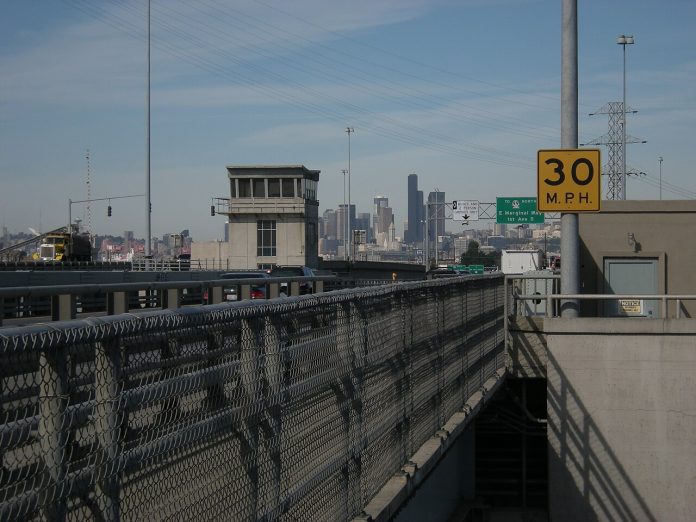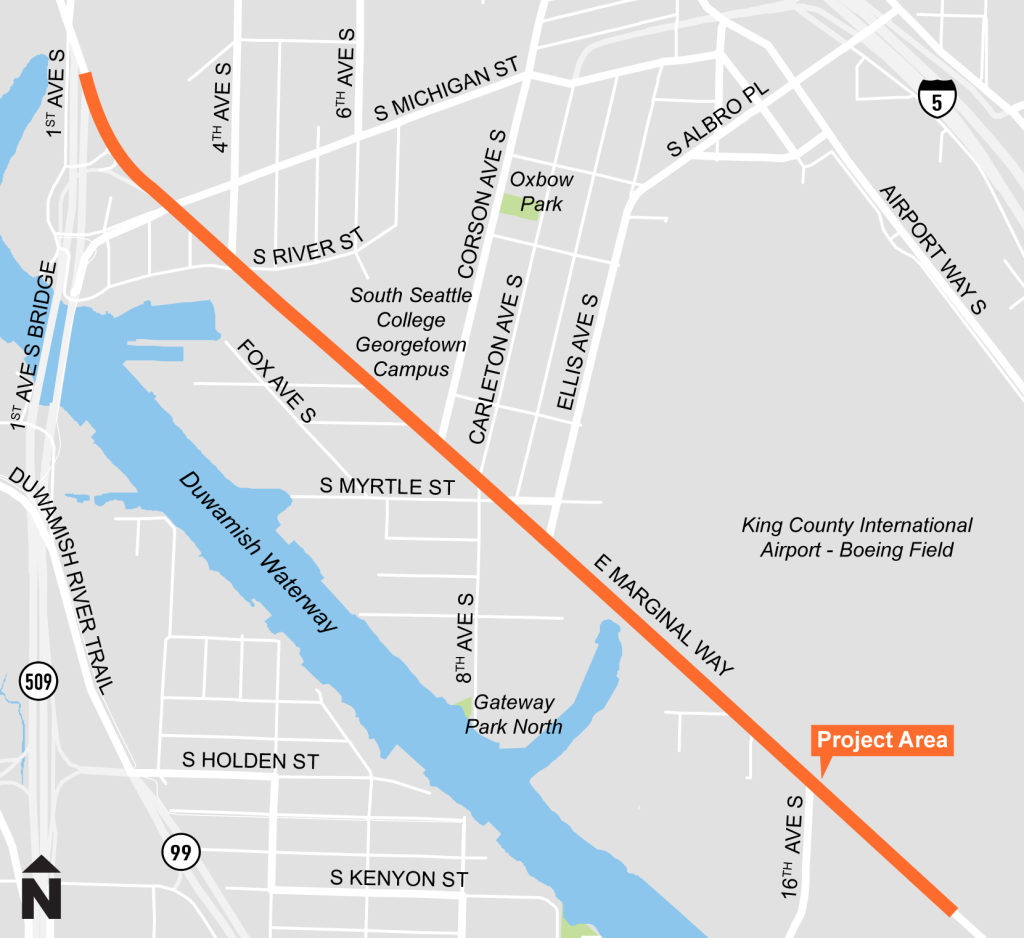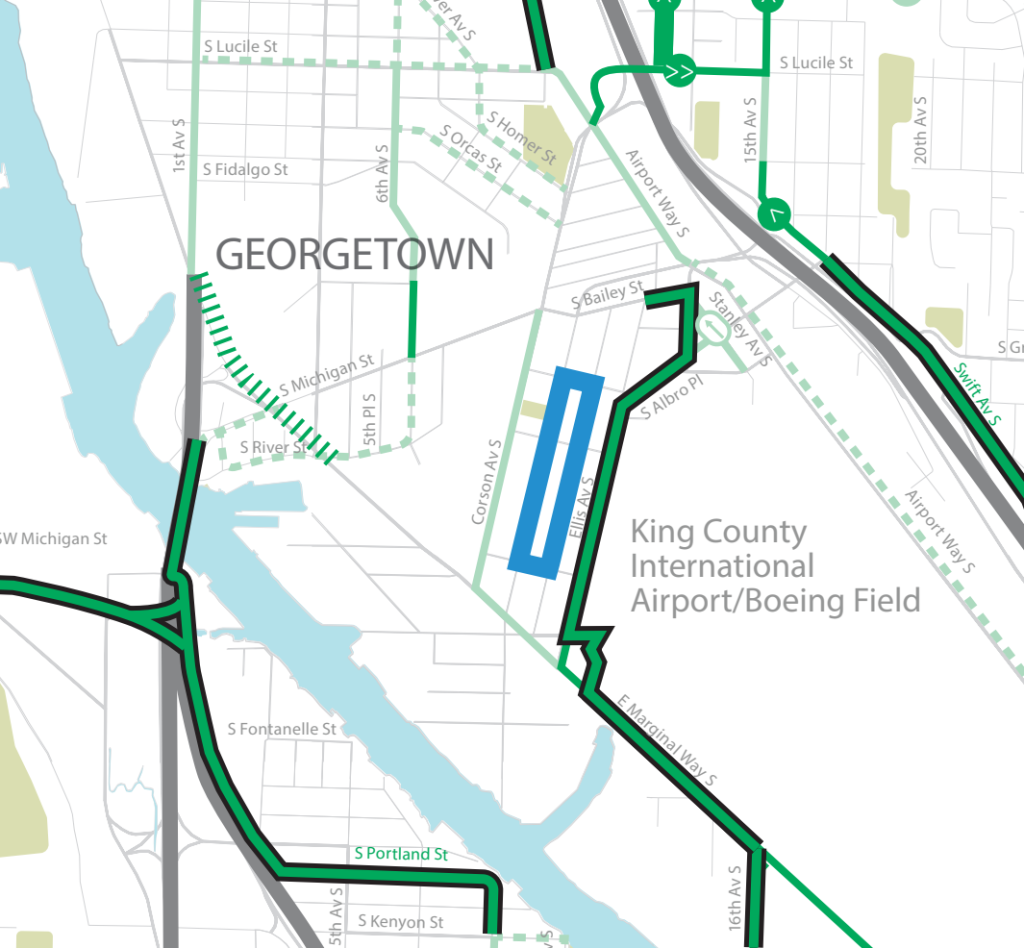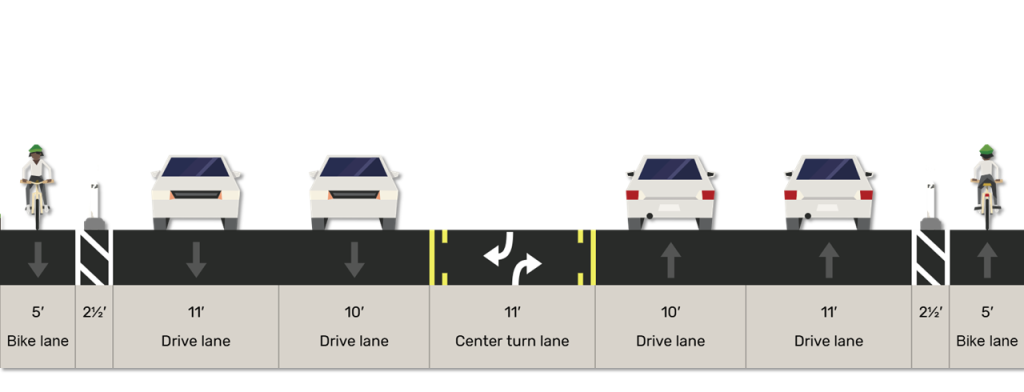
The Seattle Department of Transportation (SDOT) is finally getting close to completing the Georgetown to South Park Trail, which will fill in a longstanding glaring gap in multimodal infrastructure in the Duwamish Valley. But a new project coming down the pike has the potential to extend the reach of that new connection even more.
A East Marginal Way S repaving project between First Avenue S and Seattle’s border with Tukwila is providing the city with a big opportunity to make upgrades that will push this high-speed corridor toward becoming a more safe and accessible place. The project is much farther south than the long-planned East Marginal Way corridor upgrade going in right now in SoDo.
The Georgetown segment of E Marginal is overbuilt for the amount of traffic it carries — only around 20,000 vehicles per day between Fourth Avenue S and Ellis Avenue S. With the repaving, SDOT is proposing a number of significant changes to the street, which is five lanes wide through Georgetown.

E Marginal Way represents a litmus test for SDOT during a transitional era, as the project pipeline starts to grow under Interim Director Adiam Emery. Since the new Seattle Transportation Levy focuses resources on maintenance projects, corridor repaving projects like this are some of the biggest multimodal opportunities that the eight-year measure queues up. But that depends on individual project designs. In E Marginal’s case, the initial proposal includes fairly robust upgrades.
In recent weeks, traffic safety advocates have been disappointed by the department’s new lackluster proposals for a full corridor revamp on Aurora Avenue N. Meanwhile, Emery’s predecessor, Greg Spotts, oversaw a repaving on Denny Way that included minimal multimodal upgrades, along with initial plans for 15th Avenue NW in Ballard that were changed in response to community pushback.
On E Marginal, there’s a major potential to finally create a separated bike connection at the north end of the First Avenue S bridge, which has long been a no-man’s-land of infrastructure despite the mixed-use path along the bridge. This would be a big section of the city’s bike network to fill in, connecting more of the city with the Duwamish Trail up to Alki Beach and eventually down to the Green River Trail.

With E Marginal Way so overbuilt, SDOT proposes to make space for people who walk and bike along the street’s east side by repurposing a traffic lane for most of the corridor. South of Corson Avenue S, a new shared-use path along the east side of the street would create a new spur for Georgetown to South Park Trail, providing connections into additional parts of Georgetown, including the Healthy Street on Flora and Carleton Avenues. The project would also replace and upgraded curb bulbs at Carleton and Corson Avenues, reducing crossing distances for people walking.

North of Corson, a new two-way protected bike lane would connect to S River Street, where people on bikes could use a new bike crossing to head to and from the First Avenue S bridge. The project would also fully close a slip lane from Marginal onto Fourth Avenue S, improving safety for everyone walking, rolling, or biking in this area.

South of 14th Avenue S, and the connection into South Park, SDOT proposes to build a set of one way protected bike lanes on either side of the street, while maintaining five general purpose lanes. This connection could set up the City of Tukwila to leverage Seattle’s investment to provide a safe bike connection to the Museum of Flight, and potentially improve access to the future Boeing Access Road light rail station.

Ultimately, this project probably should be doing more to lay the groundwork for a potential protected bike lane along Fourth Avenue S, one of the few routes over the train tracks that cut Georgetown off from the rest of the city.
But the most obvious connection north is likely going to continue to be E Marginal Way, where SDOT has developed preliminary recommendations for future phases of the corridor project. Those recommendations aren’t ideal: the plan is to keep the stretch north of First Avenue S at eight lanes, with a narrow shared-use path along the sidewalk. Given how transformative the northern section of E Marginal is poised to be, there’s definitely room to be more ambitious.
But by taking advantage of this repaving project to bridge critical gaps in the network, mobility in the Duwamish Valley would be able to take a solid step forward.
You can provide feedback on SDOT’s proposal for E Marginal Way in Georgetown via this survey, open through Sunday August 24.
Ryan Packer has been writing for The Urbanist since 2015, and currently reports full-time as Contributing Editor. Their beats are transportation, land use, public space, traffic safety, and obscure community meetings. Packer has also reported for other regional outlets including BikePortland, Seattle Met, and PubliCola. They live in the Capitol Hill neighborhood of Seattle.

